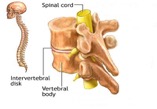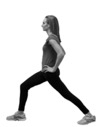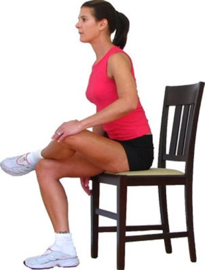Blog
30 Nov 2016
Ohhh! My aching back!
By Sue VanEvra, BSc, MSc, BHScPT, Dipl. Canine Rehab (c)
Whether you compete with your dog in sporting events or shows, work with dogs (as a veterinarian, groomer, trainer, etc), or simply walk your dog … you are constantly using your back! You might be running, lifting or carrying equipment (or your dog!), bending forward, walking holding a leash, squatting, turning, etc, etc… There are lots of ways to keep your back healthy in order to stay injury free with any activity that you do!
First, a bit about the back:
The spine is made up of individual bones (vertebrae) stacked one on top of the other; 7 vertebrae in the neck (cervical spine), 12 in the mid-back (thoracic spine), and 5 in the lower back (lumbar spine). (Interestingly, dogs have very similar anatomy with a few extra vertebrae! …but this is a topic for a whole different blog! – check out the Canine Fitness Centre website!). At the bottom of the vertebral column is a larger solid bone called the sacrum, and below that - the coccyx (best known as the tailbone).
 The spine forms an S-shaped curve which acts like a coiled spring to absorb shocks and loads. Between the vertebrae are ‘discs’ which are flexible and act to cushion the spine – kind of like rubber washers! Also between the vertebrae are joints (facet joints) that allow movement between the bones. These joints are held together by ligaments, and surrounded by many layers of muscle. Tendons are what attach the muscles to the vertebrae.
The spine forms an S-shaped curve which acts like a coiled spring to absorb shocks and loads. Between the vertebrae are ‘discs’ which are flexible and act to cushion the spine – kind of like rubber washers! Also between the vertebrae are joints (facet joints) that allow movement between the bones. These joints are held together by ligaments, and surrounded by many layers of muscle. Tendons are what attach the muscles to the vertebrae.

There is an opening or ‘canal’ in the centre of the vertebrae where the spinal cord runs. This keeps the spinal cord very well protected. The spinal cord is basically a bundle of nerves connecting the brain to the rest of the body. These nerves branch out from between the vertebrae and run to different areas of the body. The nerves stimulate muscles to work, and also send messages to the brain about sensation – some nerves allow you to feel sharp things, some send signals if there is an injury so you feel pain.

Any of the components that make up your spine are vulnerable to injury! You can sprain the joints between the vertebrae (just like you can sprain an ankle!), you can strain a muscle, injure or herniate a disc, or pinch a nerve…
What kinds of things of things make your spine vulnerable to injury?
- Lifting – this causes increased pressure on your spine – also, the heavier the object that you lift, and the further away from your body it is increase the risk of injury
- Twisting – when your hips and shoulders are not moving together – especially if it is a fast motion
- Bending forward at the waist – each small amount that you bend forward, there is an increase in pressure on your spine
- Prolonged postures – not changing position puts prolonged stress on your spine
- Poor posture – including when you are sleeping
- Tight musculature around the spine Weak ‘core’ muscles that support the spine (see below)
**NOTE – when you combine these things, there is an even greater risk! For example if you travel a long distance for an agility trial, stay in the same prolonged position in your vehicle, hop out and bend forward to lift something from the trunk of your car, and twist to put it on the ground!
Ways to prevent injuries:
• Keep your core muscles strong! The core muscles include the small muscles between each vertebrae, the deepest layer of abdominal muscles, the muscles of the pelvic floor (the ones we use to stop urine flow when making a urine sample), and the diaphragm. To activate your core, think about ‘drawing your belly button toward your spine’, while you contract your pelvic floor. **Keep an eye out for a whole blog on core strengthening, coming soon!**
• When lifting, keep the object as close to your body as possible. Tighten your core muscles before you lift, and use your legs to help whenever possible (ie squat to pick up an object off of the ground vs. bending forward at the waist) • Avoid twisting – especially when lifting or carrying anything – if you need to change direction, move your feet! And keep your shoulders and hips moving together.
• Avoid prolonged positions. If you are driving long distances, make sure to stop every couple of hours to get out of the car and move! It may take slightly longer to get there, but you’ll feel better and help to protect your back!
• Stretch! Here are a few starter stretches for some muscles that affect your spine:
- Hip flexors – on the front of the hips and attach to the front of the vertebrae in the lumbar spine. To stretch left hip flexor, stand with right foot forward, then ‘tuck tailbone under’ (backwards rotate the pelvis), then bend the right knee to lunge forward. Keep the back straight – hold for 20 to 30 seconds and repeat 2-3X each side

• Latissimus Dorsi (‘Lats’) – large muscles that span the back. To stretch them, kneel on your hands and knees, then sit back on your heels, keeping your hands in the same place. Once you are sitting on your heels, slowly inch your fingers forward as far as possible. Hold 20-30 seconds and repeat 3-5X.

• Gluteal muscles – muscles behind your hips/buttocks. To stretch the left side, sit on the edge of a chair with one foot on top of the right knee. Keep back straight, then lean forward to feel a stretch on the left side. Hold 20-30 seconds and repeat 2-3X each side.

Remember! No matter how you enjoy time with your dog, it’s important to take care of your own back so that you can continue to do what you and your dog love to do!
For more information, please contact Two Hands Physiotherapy (403-860-0058) or book an appointment for a spinal assessment and individualized home program!
